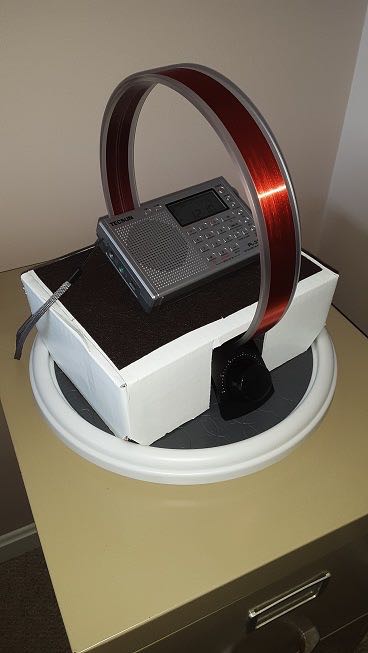Many thanks to SWLing Post contributor, Rich Stahl (WR3V), who shares his frugal but effective mediumwave DXing setup:
My MWBC directional reception on the cheap (see photo above):
Tecsun PL-310ET $40.85
Tecsun AN200 loop $12.95
Walmart Lazy susan $7.95
Cardboard box -0-Total $61.75
Who says its an expensive hobby?
Indeed! That’s a very basic, yet very effective setup, Bill. Thanks for reminding us that this doesn’t have to be an expensive venture!


If you buy the AN100 intead of the AN200 you don’t need the box
Max, I have other radios to consider that make the AN200 the better choice for me. But, I understand your and appreciate your input.
Tnx. & 73’s
Jack Blanke
WB5LVP
Metairie, LA
Very good idea, I’ll make something like that for sure (I have all the components already so why not?)
That antenna surely improves MW reception very much and making direction finding more convenient is a good improvement.
Thanks for sharing!
Memory says that tge first time I heard about “DXing” was in “Canadian Boy”, a magazine for Cubs and Scouts, about 1969.
It was of course about AM DXing, using a common house radio. It maybe showed the trick about winding some turns of wire around the radio to couple it to an outside long wire.
That got me interested, and tge radio in the living room had a shortwave band, which I doubt I’d noticed before that.
Even better, a followup.letter an issue or two later mentioned amateur radio, which somehow sounded very interesting. But you had to ge fifteen years old at least to get a license in Canada, a bit over five years in the future for me. o
But it did make me get atelegraph set to learn morse code (not a usual.method I discovered, nobody to send code to me), and read all the books about electronics in the children”s library (actually mostly books about electricity, with projects !ike two nails and an AC cord to make a hit dog cooker), but soon I got to the adukt library and real books about electronics and ham radio.
I was lucky, they changed the rules in April of 1972, so tgere was no lower age requirement and I.passed the test in June.
Michael
Good concept. I have been using a similar one for a few years with the following exceptions:
1. The AN-200 sits off to the left side of the radio with the radio raised on a box so that the axis of the ferrite loop is roughly in line with the axis of the AN-200.
2. I skipped the lazy susan. Instead, I cut a rectangle of cardboard to serve as a common base for the AN-200 and box supporting the radio. The box is glued to one side of the base. The cardboard base is merely rotated on the table to turn both the antenna and radio simultaneously.
One might try experimenting with the axial distance between the antenna and radio. I have found with some radios, peak coupling occurs with a separation of a few inches.
Bob, I agree totally. This set up works consistently well with the Tecsun PL380 because its size allows for it’s central positioning within the Loop. I have experimented with alternate placements over a number of months and have found this one provides readings approximately 5 points higher than others to the side or perpendicular to the Loop.
However — and this is going to raise an eyebrow or two — my favorite AM DX’ing radio in my limited inventory is a Sangean H210 Shower Radio!! That’s right, a radio designed for use in the shower!! While practically void of features one normally considers “must haves” in an AM DX’ing radio, my Sangean H210 boasts 2 huge advantages….Its has a monster built in ferrite antenna that grabs distant and weak AM Broadcast signals like a magnet and it also has crystal clear audio that does a great job of making the spoken work intelligible in the midst of typical QRM & QRN conditions. It also happens to be fairly selective, rejecting strong signals o adjacent frequencies. When I pair up my AN200 with the H210, I am really pleased with results. The size of the H210 precludes positioning inside the loop. Experimenting with numerous placement options over several months, I have found the most consistently effective placement of the Loop is to the side of the radio, such that the plane of the Loop is perpendicular to the centerline of the radio. I might also add that it has been my general finding that the more robust the internal ferrite antenna of the radio happens to be, the more effective the performance of the Loop will be.
At any rate, these are just my admittedly unscientific observations based on my experiences using Inductive Loops. I am certain others may have differing opinions that are more scientifically based, and I will yield to their opinions accordingly. But, I have had a ton of fun experimenting with Loops and AM band reception. I have 2 loops and have attempted using them simultaneously in all kinds of different configurations……never with any success!! But, such is the fun of enjoying AM radio!!
73’s
Jack Blanke
WB5LVP
Metairie, LA
Lazy Susan to rotate the radio and loop is a great idea, as is DX’ing the AM broadcast band. Those Tecsun loops work very well on radios with ferrite antennas. At night many stations come in from far away locations, and lots of us began our radio hobby by cutting our teeth on simple AM shirt pocket radios. Of all the bands I find the AM BCB to be the most interesting of all.
Thanks Rich and Thomas for posting.